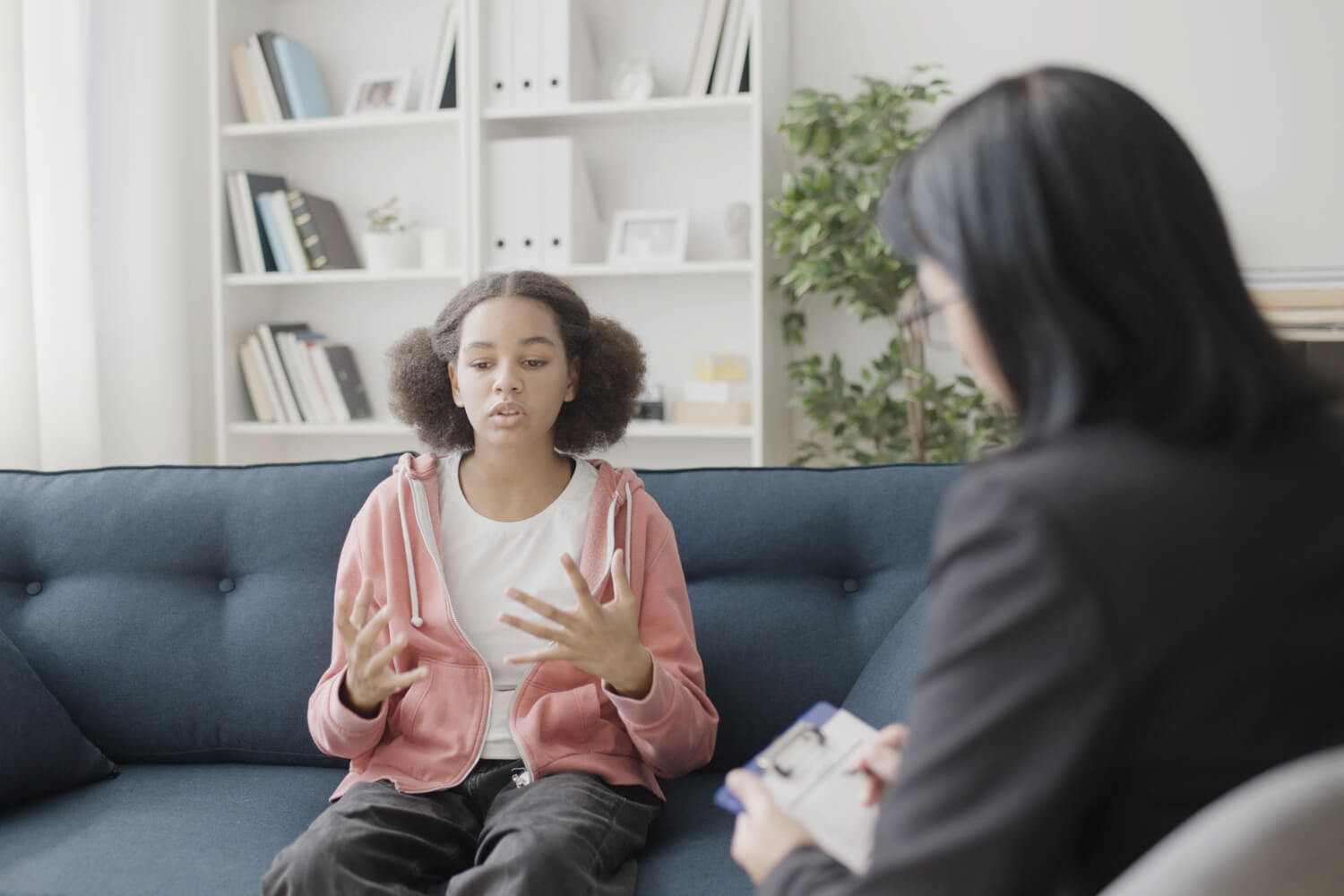Exploring the Different Sorts Of Therapy Readily Available for Teens With a Therapist for Teens
Teenagers face unique obstacles that can impact their mental wellness. Numerous therapeutic methods are tailored to deal with these issues properly. From Cognitive-Behavioral Treatment (CBT) to Art Treatment, each technique offers unique advantages. Recognizing these therapies can aid caregivers make educated choices. What elements should be taken into consideration when selecting the appropriate method for a teen? The exploration of these various treatments exposes insights that can considerably boost teenage health.
Recognizing Cognitive-Behavioral Therapy (CBT) for Teenagers
Cognitive-Behavioral Therapy (CBT) functions as an effective tool for dealing with the distinct psychological wellness difficulties faced by teenagers. This evidence-based approach concentrates on the interaction between thoughts, sensations, and habits, helping teens determine and transform negative idea patterns that contribute to their struggles. Through structured sessions, specialists assist young adults in identifying their cognitive distortions, fostering much healthier coping mechanisms and emotional policy.
CBT is especially reliable in handling anxiety, anxiety, and behavior problems, as it outfits teenagers with sensible skills to browse their every day lives. The treatment urges self-reflection and advertises a positive frame of mind, equipping teens to take control of their mental wellness trip. By setting specific goals and utilizing different methods, such as journaling and role-playing, CBT promotes strength and self-awareness. On the whole, this therapeutic method supplies teenagers with important tools to face their obstacles and construct an extra favorable outlook on life.
The Advantages of Dialectical Habits Treatment (DBT)
While lots of therapeutic methods provide important insights for teenagers, Dialectical Actions Therapy (DBT) stands apart for its efficiency in attending to emotional guideline and social challenges. Developed by Dr. Marsha Linehan, DBT incorporates cognitive-behavioral techniques with mindfulness methods, making it specifically suitable for teens coming to grips with intense emotions. This treatment aids teens identify and understand their feelings, promoting healthier reactions to stress factors.
Among the substantial advantages of DBT is its focus on building abilities in four key locations: mindfulness, interpersonal performance, distress tolerance, and emotional guideline. These abilities equip teens to browse complex relationships and cope with tight spots better. In addition, DBT urges a strong therapeutic partnership between the specialist and the teen, fostering count on and visibility. Because of this, many teens experience boosted emotional stability and boosted coping devices, eventually resulting in an extra satisfying life and stronger partnerships with peers and family.
Exploring Art Treatment as an Innovative Outlet
Art treatment provides young adults a special avenue for self-expression and emotional expedition (Therapists For Teens). With numerous techniques and techniques, it allows them to interact feelings that might be tough to articulate verbally. By involving in creative tasks, teens can experience therapeutic benefits that promote psychological well-being
Benefits of Art Therapy
Participating in art treatment offers teenagers with an one-of-a-kind imaginative outlet that promotes psychological expression and individual understanding. This therapeutic approach permits teens to connect sensations and experiences that may be challenging to verbalize verbally. With numerous types of creative expression, such as attracting, paint, or sculpting, teenagers can discover and refine complicated emotions, resulting in increased self-awareness. Additionally, art therapy advertises relaxation and anxiety relief, supplying a safe room for people to release pent-up emotions. The non-judgmental environment encourages experimentation, helping teens build self-confidence in their imagination and analytical skills. Consequently, art treatment can boost overall psychological health, offering a useful device for handling life's challenges throughout this crucial developmental phase.
Strategies and Approaches
When checking out art therapy as an innovative outlet, various strategies and techniques can be employed to help with psychological expedition and expression. These might consist of drawing, painting, collage-making, and sculpting, allowing teenagers to interact sensations that may be tough to verbalize verbally. Assisted images can also be utilized, urging individuals to visualize and develop representations of their feelings. Additionally, the unification of songs or activity can improve the creative procedure, fostering a deeper connection to their inner experiences. Team art activities supply chances for social communication and shared healing. Notably, the emphasis in art treatment exists not on imaginative ability however on the process of creation, equipping teenagers to find their very own distinct kinds of self-expression and insight.
Art as Expression
Creative thinking functions as an effective conduit for self-expression, especially for teenagers steering intricate feelings. Art treatment provides a special electrical outlet for adolescents to discover and communicate feelings that might be challenging to verbalize verbally. With drawing, painting, or sculpting, teens can envision their inner struggles, cultivating a feeling of understanding and launch. This restorative strategy enables individual analysis and motivates exploration without judgment. In addition, taking part in creative activities can improve self-worth and advertise emotional strength. As teens develop, they might find new viewpoints on their obstacles, resulting in healing and personal development. Eventually, art therapy acts as a necessary resource, empowering adolescents to navigate their emotional landscapes with innovative expression.
The Role of Household Therapy in Adolescent Mental Wellness

Benefits of Household Involvement

Communication and Dispute Resolution
Effective communication and problem resolution are important elements of teen mental health, especially within the context of family members therapy. Family treatment supplies an organized environment where teens can express their thoughts and sensations, fostering open discussion. This healing setting urges household participants to actively listen to each various other, promoting understanding and compassion. By attending to conflicts in a safe room, teenagers discover useful abilities for handling disagreements constructively, which can minimize psychological distress. Additionally, these abilities enhance household dynamics, causing healthier connections. As teenagers navigate the complexities of their feelings, family members treatment equips them with tools to communicate effectively, resolve problems amicably, and reinforce domestic bonds, eventually supporting their general mental well-being.
Making Use Of Mindfulness-Based Therapy for Stress Reduction
As adolescents navigate the intricacies of teenage life, integrating mindfulness-based therapy can offer as an effective device for stress and anxiety decrease. This restorative strategy emphasizes present-moment awareness, aiding teens challenge their ideas and feelings without judgment. By exercising mindfulness strategies such as deep breathing, body scans, and directed images, adolescents can discover to handle anxiousness and anxiety better.
Research study suggests that mindfulness-based treatment can boost emotional law and resilience in teenagers, permitting them to deal much better with social challenges and scholastic stress (Youth Counsellor). Regular method can lead to enhanced emphasis, reduced impulsivity, and greater total wellness. Additionally, mindfulness cultivates a feeling of connection to oneself, advertising self-compassion and minimizing negative self-talk
Integrating mindfulness right into treatment sessions supplies teens functional approaches they can use in day-to-day life, encouraging them to browse stressors with greater convenience and confidence. Because of this, mindfulness-based therapy becomes an essential source in sustaining adolescent psychological health and wellness.
Integrating Play Treatment for Younger Teenagers and Preteens

Specialists learnt this technique develop a risk-free atmosphere where more youthful teenagers can discover their problems and establish dealing methods. By participating in play, these people can much better comprehend their feelings and learn to steer social interactions. In addition, play therapy can promote resilience and problem-solving skills, vital for navigating the challenges of adolescence. In general, incorporating play treatment can boost the therapeutic process, supplying younger teenagers and preteens with the devices they require to grow psychologically and socially.
Frequently Asked Concerns

How Do I Know if My Teenager Requirements Therapy?
Indicators that a teenager may require treatment include relentless unhappiness, modifications in habits, withdrawal from activities or buddies, scholastic decline, boosted stress and anxiety, material use, or difficulty handling life modifications. Observing these signs can trigger professional examination.
What Certifications Should I Look for in a Teen Specialist?
When looking for a teen specialist, one ought to focus on qualifications such as pertinent degrees in psychology or therapy, state licensure, specialized training in adolescent concerns, and experience dealing with young adults in different restorative setups.
How Can I Support My Teenager Throughout Therapy?
To support a teenager throughout treatment, one should actively listen, provide encouragement, respect their personal privacy, and validate their sensations. Additionally, promoting open interaction can help them really feel more comfortable reviewing their emotions and experiences.
What Are Usual Indications of Mental Health And Wellness Issues in Teenagers?
Common indications of psychological wellness issues in teens include persistent sadness, withdrawal from tasks and friends, adjustments in rest or cravings, problem focusing, increased irritation, substance abuse, and visible declines in academic performance or self-worth. (Youth Counsellor)
How Much Time Does Treatment Normally Last for Teens?
Therapy period for useful reference teenagers generally differs, frequently lasting from a few weeks to a number of months. Aspects influencing this timeline include the person's details requirements, the kind of therapy, and progress made during sessions.
From Cognitive-Behavioral Treatment (CBT) to Art Therapy, each method offers distinctive benefits. Cognitive-Behavioral Treatment (CBT) offers as a powerful device for addressing the special mental health and wellness challenges encountered by teens. Engaging in art therapy supplies teenagers with a distinct imaginative outlet that cultivates psychological expression and personal insight. Family members treatment provides an organized setting where teens can express their feelings and ideas, cultivating open dialogue. Research suggests that mindfulness-based treatment can enhance emotional law and durability in teens, enabling them to cope better with academic pressures and social challenges.